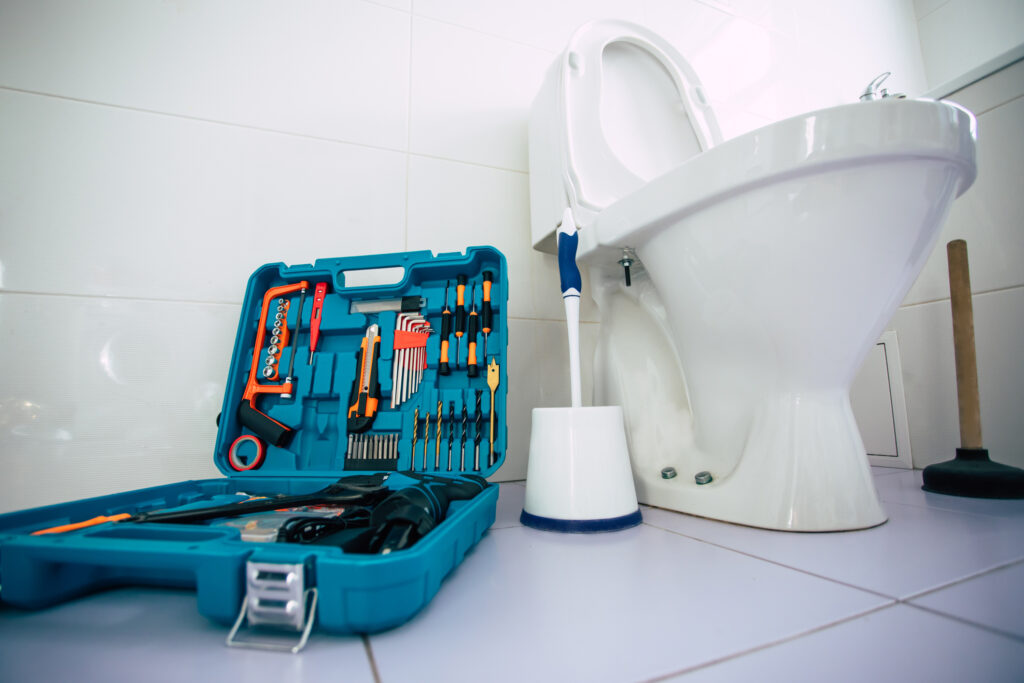Common Toilet Problems
Common Toilets Problems and DIY Fixes
At Staggs Plumbing, we routinely receive calls from homeowners because of an issue with their toilets. Many of them have simple and inexpensive fixes, while others may require the services of a professional plumber. A constantly running toilet will increase your water bill. In times of drought restrictions like we had in the Plano and Dallas Texas areas in recent years, homeowners should be especially aware of wasting water.

Shut off the Water for Toilet Repairs
Under every sink, and next to every toilet, there are water supply lines connected to a shutoff value. Some are known as quarter turn, others are multi turn shutoff valves. Simply turn them clockwise to shut off the water supply to the toilet. If they do not fully shut off, you need to call a plumber to replace the valves before you attempt any repair work on your toilets.
The picture below shows hot and cold shutoff valves underneath a sink. There will only be one shutoff valve for a toilet – the cold water supply line.
Water Trickles Into the Bowl / Flushes by Itself
You might hear the toilet flushing by itself or notice water running into the bowl, even though it hasn’t been flushed.
It is normally caused by a very slow leak from the tank into the bowl because the flapper has either deteriorated over time so it cannot make a clean seal of the flapper seat has been worn or damaged.
To check, lift up the tank lid and check to see if the flapper is centered over the drain hole. Flappers are very inexpensive and can be purchased at your local hardware store. It’s always a good practice to replace toilet flappers every few years simply because they wear out over time.
- Turn off the water supply to the toilet
- Drain the tank.
- Gently replace the flapper inside the tank, hooking up the chain to the flush arm.
- Check for and clean off any debris around the tank seal.
In some cases, the cause of an intermittent toilet flush is caused by the next issue…
Water Trickles Into the Tank
If water is constantly flowing into the toilet tank, there are several possible reasons:
- The float (if used) is stuck or broken
- The overflow tube is pushed too far into the overflow pipe. It acts as a siphon, pulling water from the tank into the bowl. It should only extend about 1/4″ below the top of the overflow pipe.
- The valve assembly is worn out or needs adjusting. The valve assembly turns the water supply off or on depending on the water level. Valve assemblies usually cost less than $20, as do most of the other parts inside a toilet.
If you don’t feel comfortable replacing parts within the toilet, just give Staggs Plumbing a call, and we’ll come over and get it sorted out quickly.
Toilet Bowl Empties Slowly
If your toilet is flushing slowly, usually it’s because of clogged holes underneath the rim of the bowl. You can use a curved piece of wire (like a coat hanger) to poke into each flush hole to clear out any debris. The siphon jet in the bottom of the bowl can also be cleared with this method, however, be careful not to scratch the surface of the bowl.
Clogged Toilets
This is one of the most common problem calls that we receive. There are many tools can help you clear a clog in the drain. Your local hardware store normally carries a force-cup plunger, which is more effective than the familiar standard type for clearing minor clogs. To clear the clog, insert the bulb into the drain, and push down on the handle forcefully. Slowly release the handle, letting a little water in so you can see whether the drain is clear. Repeat if necessary.
For bigger clogs, try using a closet auger. You can usually rent these if you’d rather not invest in something you’re not likely to use very often. Insert the end of the auger into the drain hole, and twist the handle as you push the rotor downward. Use caution not to scratch the bowl.
However, if there are some hard objects (like a child’s toy for example) stuck in the toilet drain, then this is not a DIY job, and it’s time to call the experts at Staggs Plumbing.
Toilet Seal Leaks
Most toilets have at least five seals that can wear out and leak over time. The solution is to identify the faulty seal and tighten or replace it.
Leak at the Seal Between Tank and Bowl
Between the tank and the bowl is a large seal. A break here will cause a major leak, with water coming out from underneath the tank when the toilet is flushed. To replace this seal:
- Turn off the water supply to the toilet
- Drain the tank.
- Remove the tank by loosening the bolts that secure it to the bowl.
- Remove the old seal from either the tank or from inside the top of the toilet.
- Dry the outside of the tank and inspect for any other damage.
- Clean around the area that the tank sits on.
- (Pro tip) Often when your bathroom is painted, because of the closeness of the tank to the wall, it is very hard to paint the wall behind the tank. Now that the tank is off, you can paint the rest of the wall.
- Replace the seal.
- Attach the tank to the toilet base and finger tighten the bolts to secure. If the bolts are tightened up too much, it could crack the porcelain tank.
- Test by flushing multiple times and looking for leaks around the bottom of the tank.
Leaks on Bottom of Toilet Tank
If the small seals around the tank bolts are not snug between the bowl and tank, water will escape. Sometimes you can simply tighten up the bolts from underneath the toilet. Take care not to tighten them up too much at risk of cracking the porcelain tank.
If this is not successful, you will have to replace the seals around the tank bolts.
- Turn off the water supply to the toilet.
- Drain the tank by flushing the toilet.
- Remove the tank bolts from inside the tank by loosening the nuts from underneath the tank.
- Lift off the tank, clean up and dry.
- Using new nuts, bolts and washers, reassemble the tank assembly.
Leak from the Toilet Base
Between the toilet base and the floor is a wax seal and plastic flange. If you see water coming out at the base of the toilet, it’s usually either a wax ring failure or the base of the toilet has not been tightened enough to create a strong seal around the wax ring.
This job is usually when you call in a professional plumber like Staggs Plumbing. It’s a more complicated job to perform and can get messy. If the toilet flange is damaged, then the job is made even harder.
- Wear gloves!
- Shut off the water supply and disconnect the supply lines.
- Remove the water tank.
- Remove the bolts that secure the toilet to the floor.
- Lift up the toilet base, taking care not to allow water to splash out. (you can tip it out over a bathtub)
- Remove the old wax seal and inspect the toilet flange for any damage.
- If you have tiles on the bathroom floor, you may need an extra deep wax ring.
- Clean off the area for the new wax ring.
- If the flange in the floor is broken, you will need to call a professional plumber.
- Reassemble the toilet assembly.
- Flush several times and inspect for leaks.
- After a few days with no leaks, run some caulking around the toilet base.
Leak from the Cold Water Supply Line
If a supply line has been installed incorrectly or it simply wears out, you will notice water around the supply lines. The supply line connects between the shutoff valve on the wall and the inlet on the bottom of the toilet tank.
If it’s simply a case of being too loose, simply hand tighten and then tighten 1/4 to 1/2 turn with a wrench.
If the supply line is broken, turn off the water at the shut off valve and replace with a braided steel type. They typically run around $10 at your local hardware store. Make note of the size at each end as well as the length.


